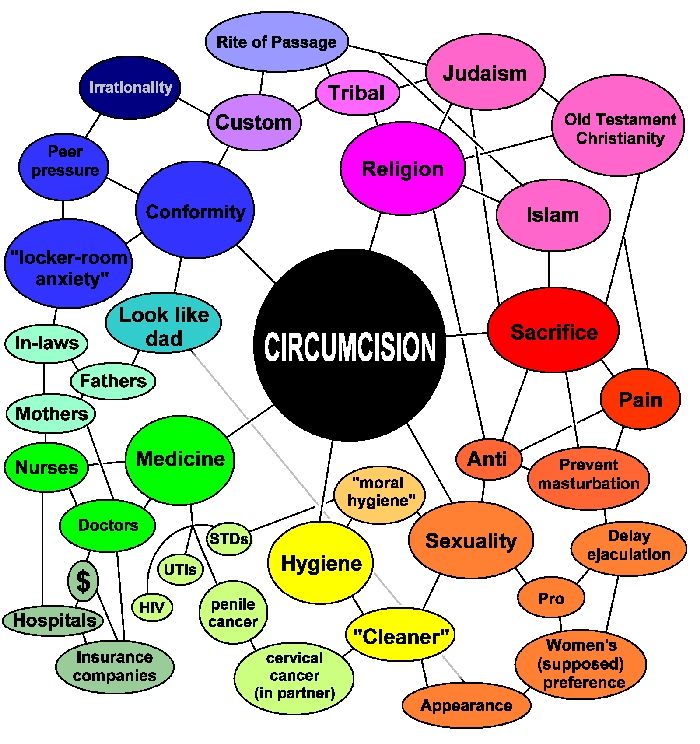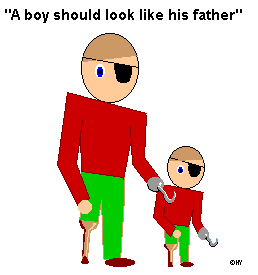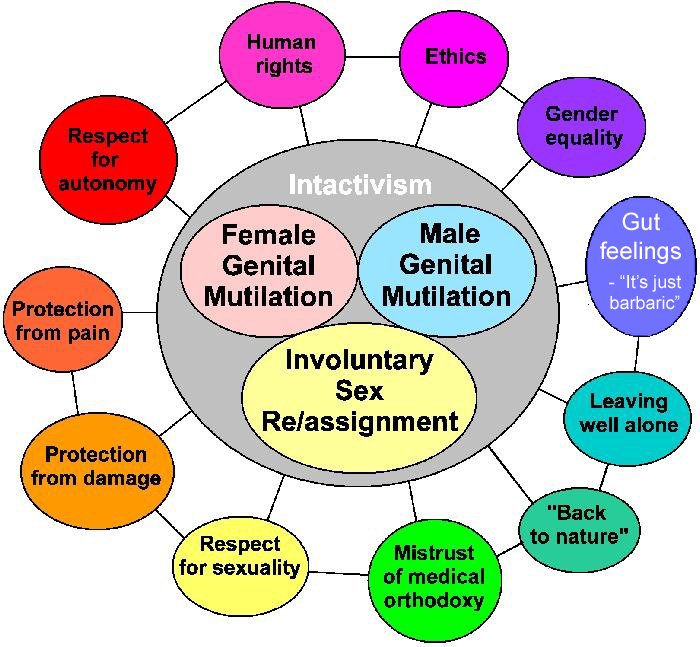| |
Circumcision as a Memeplex
- talk by Hugh Young at the Eighth International Symposium
on Circumcision and Human Rights,
Padova, Italy, September 3, 2004
Paper published in "Bodily Integrity and the Politics of Circumcision:
Culture, Controversy, and Change"
eds Denniston GC, Grassivaro Gallo P, Hodges FM, Milos MF and Viviani, F.
Springer 2006
A meme is "a unit of cultural transmission, or a unit of imitation"
- Richard Dawkins
|
Common examples of memes are
- tunes, like "Happy Birthday to You" or your national anthem (four notes is thought to be the minimum)
- catchphrases, like "Like father, like son" or "blood, sweat and tears"
- myths, like George Washington chopping down the cherry tree, or the tooth fairy
- folk beliefs, like "We only use 10% of our brains" and
- customs, like tossing spilt salt over your left shoulder and genital mutilation.
(Dawkins cites “tunes, ideas, catch-phrases, clothes fashions, ways of making pots or of building arches”.)
A cluster of related memes is a memeplex. (Dawkins called it a “co-adapted meme-complex”, but the name of the meme has evolved.)
Examples of memeplexes are
- languages, and subsystems of languages such as alphabets, fonts, dialects and regional accents
- clusters of customs, such as Christmas celebrations
- systems of thought, such as philosophies and religions [except our own, of course]
Memes, like genes, are replicators - they copy themselves - an
amazing property, when you think about it, the basis of life itself.
Like genes, memes endure and copy themselves with variations,
which are naturally selected, and thereby evolve. Like genes, they are
"selfish" - or rather, their function is the promotion of their own survival.
...all that counts in the life of a meme is whether or not it survives
and replicates. ... we must remember that [saying that memes 'want',
'need', or 'try to do' something] is only shorthand for saying that the
'something' will improve the chances of the meme's being copied. Memes
do not have conscious intentions; nor do they actually strive to do
anything at all. They are simply (by definition) capable of being
copied, and all their apparent striving and intentionality comes from
this. - The Meme Machine, p 162
|
Unlike genes, only human (and possibly some primate, and electronic) brains carry memes.
A good analogy for a meme today is a computer virus. In fact, a
computer virus, being merely information stored in, and transmitted
between, information processsing systems, is more like a meme than it
is like a biological virus (which is a self-contained physical entity
that actually moves between organisms, carrying genetic information
with it). Richard Dawkins says that as
with genes, we track memes through populations by their phenotypes
[ways of being physically expressed]. And he cites circumcision as a
rare example of a meme phenotype that is part of a living body, like
most gene phenotypes. He says a Martian geneticist ...
… would have to work quite hard to discover that no genes are involved
in the genesis of the "roundhead" (circumcised) phenotype.
Susan Blackmore suggests that the taboo on masturbation, and
circumcision, both have the evolutionary function of increasing the
amount of vaginal sex, and hence the number of offspring to whom the
taboo can be taught. Enter evolutionary biology. But there is no
evidence that circumcision significantly increases the birthrate, and
many circumcised men claim circumcision does not make masturbation more
difficult. But the belief that it did was sufficient to establish it in
the UK and then the US, late in the 19th century, and once established,
it sustained (and sustains) itself by associated memes that had (and
have) nothing to do with masturbation or sex. In fact, for most of the
20th century, any role of the foreskin in sex has been ignored or denied in circumcising cultures.
While Dawkins and Blackmore consider circumcision a meme, the
central idea - cutting part of a baby's or child's penis off - is
always embedded in culture, tradition, religion and/or medicine.
(Nobody could reasonably consider that cutting part of a baby's
genitals off, without some supposed benefits or context, was a good
idea in and of itself.)
The genesis of this website was the list of reasons to circumcise. There seemed just too many, maybe 30. There are now more than 450. Fortunately, the reasons fall into some general classes:
:

The Circumcision Memeplex
This diagram does not include circumfetishism - circumcising or
being circumcised for sexual pleasure, though there is reason to
suspect it's often hiding not far under the surface.
Ritual circumcision and Routine Infant Circumcision [that is,
without immediate medical reason] might almost be considered different
memes that happen to share the same phenotype: - Muslim ritual circumcision, done in childhood, is
associated with ideas of ritual cleanliness, conformity, and as a rite
of passage to manhood, as well as the belief that it is required by
Islam. Customs vary across the huge Islamic world, but it is usually
associated with celebration, feasting and treating the boy as "Prince
for a day" - all parts of the Muslim memeplex that cement it into that
culture. We have one report that Muslim circumcision is surgically much
milder than western “medical” circumcision, and this could explain how
it can be done to boys old enough to speak.
- Jewish ritual circumcision takes place at a social occasion
for adults (where the emphasis is on food - the baby and what is done
to him become almost irrelevant. and it is common for a meal
celebrating a symbolic act to take centre-stage and eventually replace
the act, so it would be a good idea for Brisot Shalom to have better
than average catering). It is much later that he is explicitly taught
about its significance (the meme is transmitted very deliberately) -
though that significance itself is a whole complex of ideas, some
unrelated:
- To keep a bargain Abraham made with G-d
- As a badge of Jewish identity. / To make him look different from outsiders
- To remind him of anti-Semitic persecution / To bond him with his community / To educate him in his parent's faith
- "... because Jewish men should be able to feel the pain of others more easily."
- To symbolise humanity's unique essence as more than animal
- To offer our children to a higher spiritual life / To ensure a share for him in the world to come
- To draw down the Divine light, bring down the soul of holiness
into the body, reveal the Jew's inherent connection to G-d / To signify
the union of body and spirit
- Because "[t]his paring away of the superfluous skin allows
for Shechinah energy (the 'essence' of the Universal Deity) to permeate
the seed of Israel."
- Because the foreskin concentrates negative energy / To
"spiritually remov[e] and eliminat[e] undesirable character traits... /
...depressive tendencies and so on...
- ...[To] eliminate from the body of the child, forces which might try to cultivate overindulgence in physical pleasures, etc."
- For "its positive effects on the generations to come."
These may be summarised as
- identity (yet it is generally agreed that circumcision is not what makes a boy Jewish) and
- supposed spiritual benefits; and we can't deny the good
feeling some Jewish men claim from being circumcised, of continuity
with their age-old tradition.
but ritual cleanliness is the invisible guest at the feast. Jewish
defenders of circumcision frequently cite cleanliness and express
horror at the supposed uncleanliness of the foreskin.
"Opening the draw string of his pants, he allowed the filth of his uncircumcised penis to unsheathe into the air."
- "The Last Kabbalist of Lisbon" by Richrd Zimler
|
In the USA, Routine Infant Circumcision is perpetuated by a stealth
akin to that of the stealth bomber. It makes itself invisible to our
radar. - It is usually done out the parents' sight and hearing -
and they were once not even told it was to be done. Two parents might
agree to circumcise their son for reasons that have nothing in common -
might even be contradictory - and never share their reasons.
- Its victims are discouraged from discussing it or even
thinking about it. This silence has one component that is peculiar to
circumcision and another that arises from the taboo on sex. Thus the
transmission of the meme is often done indirectly, through euphemism
("a little snip") and with a kind of desperate jocularity. (“I'm just
taking him away for his circy.”)
The ostensible reasons are
- medical, and hygiene and cleanliness
- supposed psychological benefits of looking like the father
- coupled with tradition and custom
- sexual, coupled with women's supposed preference
- fear of difference, projected into the child's future locker-room experiences
Each of these is a cluster of ostensible reasons, sometimes
contradictory - for example both to increase and to decrease penile
size or sensitivity.
The constituent memes of Jewish circumcision and Routine Infant
Circumcision in the US are like the two members of a double star
orbiting each other, influencing each other while keeping their
distance - with Jewish circumcision the shining star, Routine Infant
Circumcision a black hole, sucking parents and babies in. The
interaction can be seen in many TV sitcoms - Seinfeld
is a good example - where the circumcision being discussed is
ostensibly Jewish, but stripped of any religious connotations, and many
of the other "reasons" are invoked. A large but unknown number of US
Jewish babies are reportedly circumcised in hospital without ceremony
before the eighth day, nullifying any covanental value, but satisfying
other memes of the memeplex.
The most effective memes are simple and couple the behaviour with something universally agreed to be good:
God said we must circumcise
All the nicest people are circumcised / Circumcision is American
Circumcised penises are cleaner
Circumcision protects against AIDS (or cancer or UTIS or STDs
or whatever is the most feared disease of the day)
|
And these associations make them hard to argue with.
Good advice to a potential meme is: if you want lots of rehearsals (replications), try to look important!
- Daniel C. Dennett, Breaking the Spell, p121
|
Circumcision is presented as "an important decision parents must
make for their children" - yet any opposition to doing it may be
dismissed because "it's no big deal".
The Altruism meme
Altruism is a powerful way of spreading memes - and hence many memes spread by linking themselves to altruism.
People
are nice to each other to get kindness in return, and their emotions
are designed appropriately. ... Kind and generous behaviours will
spread by imitation, .. behaviours that look like kind and generous ones, or are prevalent in kind and generous people, will also be spread by imitation.
...if you are in a community that uses reciprocal altruism, you
are likely to gain most by being with people who are known to be
generous. So the generous people will have more contact with others and
therefore more opportunities for spreading their memes. - The Meme Machine, p156
Memes which have nothing to do with altruism can benefit from
"copy-the-altruist" by just tagging along for free. ... we can expect
memes to have devised strategies for getting into altruistic people
without actually being altruism memes themselves (or more accurately,
memes that happen to have such strategies should have survived better
than those without, and we should be able to observe them around us).
Are there such examples? Yes. They range from little groups of co-memes to very
complicated memeplexes. ... the essence of any memeplex is that the
memes inside it can replicate better as part of the group than they can
on their own. ibid. p 168
|
Circumcision is an excellent example of such a memeplex - the
cluster of ostensible reasons for doing it is hydra-headed and
ever-changing. The silly ones are carried on with it, as well as those
with any validity at all.
The ostensible reasons for infant circumcision always have an
altruistic component. Even the reason “to punish him for masturbation”
was only prevalent when that was believed to be for his ultimate
betterment, including the salvation of his immortal soul.
Certain memes, like wearing a turban or abstaining from certain
foods are carried along as markers of other religious memes, so that
those who share them will be altruistic toward each other. Unlike those so-called “beneficent norms”, religious, ritual and
"medical" circumcision (and FGM) are forced on infants and children by
adults who have already undergone it themselves. The ones who perform
it are not those who suffer (now). Their culture or religion has taught
them that it is "inevitable" and "necessary" and “beneficial” so that
they are able to suppress their natural revulsion, and even wallow in
their own empathy with the child's pain. If they remember the pain,
they may consider that it, too, is valuable, as Nelson Mandela does. So
by a variety of dodges, the circumcision meme can pass itself off as
altruistic. Or rather, people infected with it can.
Or circumcision may seem to benefit someone else, and two important memes of this kind are complementary, but not exactly so:
"A boy should look like his father" | "Women prefer circumcised men" |
This seems to be spread mainly by women (for a
man to say it makes it too clear that it is about his insecurities, not
the boy's). There is certainly no clamour from boys demanding to be
circumcised for this reason. | This seems to be spread
mainly by men (it may be believed by women, whatever they themselves
prefer - but women who do themselves prefer circumcised penises are
more likely to believe it). |
This links to the more general "looking like his father" that assures paternity. | After all, women don't need to be told what women prefer. |
It may be that the meme "a boy should look like his father" has a basis in biology:
- Species that survive, do so because they behave in ways that promote the survival of their own genes
- Individuals promote the survival of their own offspring and (in the
wild) have no interest in the offspring of others (or even a negative
interest, as where an incoming alpha male kills the offspring of his
predecessor)
- Appearance is one of the ways individuals recognise their own offspring.
- A male may be less likely to bond with his son if the
appearance of his son's genitals is markedly different from his own.
(This fails to explain how he bonds with his daughters, but that may
have a quite different mechanism, as the bond is different)
- The boy's mother may fear that the father will not bond if their appearance is not similar, and collude with making them match.
The question arises, how could circumcision get established if intact fathers risked failing to bond to their circumcised sons?
Answer:
In both the mythical (and probably the actual) origins of the religious
rite, and the historical origins of the surgical rite, boys out of
infancy were circumcised for a generation or more before infants were,
so intact fathers had intact sons, who grew up, were circumcised, and
became circumcised fathers of sons they then had circumcised. So there
was no time when many intact fathers had circumcised sons. How, then, did circumcision come to an end in Britain and New Zealand without demur from the circumcised fathers of intact sons?
A partial answer is that fathers (and mothers) were not consulted. The meme was never given the opportunity to be invoked.

|
The meme "Women prefer circumcised penises" is
likely to spread among men wherever a majority of men are circumcised,
whether there is any truth to it or not. Women are more likely to say,
"I prefer intact/circumcised penises" than to claim to speak for all
women - but more likely than either to have no preference, but rather,
to judge each man on his personal qualities. The meme is extremely strong where circumcision is tribal, and
hence universal within the tribe, taking the extreme form "No woman
will look at a[n intact] man." Women in bars in Samoa are said to check
European men out manually before agreeing to go with them.
If women hear the meme, they are likely to assume that men are
speaking from experience, not just wishful thinking. If they are smart,
they will not hurt circumcised men's vanity by telling them that they
have no preference (or actually prefer intact penises). So men's belief
in the meme is reinforced and not challenged.
It seems like another reason to circumcise babies, so more
babies are likely to be circumcised where it is believed, giving rise
to another generation of circumcised men to spread the meme. The Williamsons' study
shows that it is widely believed where the great majority of men are
circumcised - even by women who have no basis for comparison.
There is no corresponding meme "Women prefer intact penises" in
communities (most of the world) where most penises are intact, not
because women don't prefer them, but because intactness is spread
genetically, not memetically. Intact penises don't need memes to
spread, only genes. Circumcision needs memes.
"From now on, I'm thinking only of me."
Major Danby replied indulgently with a superior smile: "But, Yossarian, suppose everyone felt that way."
"Then," said Yossarian, "I'd be a damned fool to feel any other way, wouldn't I?"
- Joseph Heller, Catch-22
This is the principle of "runaway sexual selection": females
prefer some characteristic, such as long tail feathers in males, even
though - or even because - it puts the males at a disadvantage, so more
males are born with longer and longer tail feathers, and more females
prefer them more strongly. If a female lacks the preference and mates
with a male with short tail feathers, her short-tailed male offspring
are less preferred by the next generation and her preference dies out. |
In the same way, it makes genetic sense for women to prefer the kind of man (they think) most women prefer.
|
| Female Genital Mutilation: |
The meme "A girl should look
like her mother" is not greatly recorded in cultures that practise FGM.
This is probably because questions of maternity (who the mother is)
seldom arise. Nor is there any danger that a girl will not bond with
her mother. FGM is generally committed after she has done so. |
The meme "Men prefer circumcised women" is very strong in cultures that practise FGM - in fact it takes the extreme form "She must
be circumcised or no man will want to marry her." This is probably
spread more by women, with men collaborating, not by positively
preferring circumcised women in the first instance, but by refusing to
take a woman who has placed her suitability in doubt by being rejected
by all other men. |
| Intersexuality::
When a child is born intersexed, their
parents and their deliverers are thrown into a panic, because the meme
"A human is male or female" is immensely strong, being built into all
the memes associated with our sexuality and intimately associated with
our genes. What is striking is that the surgical action that is taken
in response to that panic has little or no bearing on the child's genes
or their reproductive future, but almost entirely on the appearance of
their genitals. |
The Spanner in the Works
Meanwhile, the irrational aspect to the circumcision memeplex adds a
complication. Circumcising a baby is Doing Something (at a particular
time and place), so it has a definiteness about it that Leaving The
Baby Alone does not. In fact US mothers who leave their babies intact
are frequently accused of neglect. Circumcision leaves a vivid mark of
having been done. It does not usually do sufficient harm at any one
time to be genetically or socially contraindicated - unlike, say,
castration. (There is some suggestion that ritual circumcision may have
been introduced in Egypt as a substitute for ritual castration - of a
priestly caste, rather than the whole male population, obviously.) The
good that circumcision supposedly does is set in the unforeseeable
future. (In this, circumcision is like those religion memes that
promise infinite and eternal rewards or punishments after death.) Since
the evils it is supposed to prevent are rare, it is allowed to take
credit by default for their absence, something like a lucky charm, or
wearing garlic to ward off vampires. Is this concept productive?
Reviewing a book of Dawkins', Simon Blackburn argues against
treating memes as having purposes or designs, which of course they do
not. But while they are in people's heads, memes are subjected to those
people's purposes and designs, and hence to creative, evolutionary
processes. And for memes, acquired characteristics (changes to the meme
phenotype between transmissions) ARE inherited, unlike those of genes.
(That is, meme evolution is Larmarkian, as well as Darwinian.)
For example, secular circumcision quickly evolved from being a
childhood treatment for masturbation to an infant preventative of it,
largely because newborns can put up less resistance. (Jewish
circumcision probably moved in the same direction in ancient times.
Muslim, Korean and Philippine circumcision have yet to do so. They are
also reportedly milder than the Jewish and US forms.) And when
masturbation hysteria waned, people's wish to circumcise, which is the
heart of the circumcision memeplex, has attached and reattached itself
to successive diseases it was alleged to prevent.

The concept of a meme or memeplex is particularly productive with
regard to genital mutilation, because the idea of genital mutilation
has a coherence of its own that is independent of individual
rationality.
Is intactness, then, also a meme?
An intact penis (or female genitalia) are not themselves memes (nor
meme-phenotypes), because they are transmitted by genes, not by
imitation. In the context of a strongly circumcising culture, it may
require unusual determination to break the hold of the circumcision
meme, but, for the most part, leaving a baby alone needs no reason.
However, Intactivism, the campaign for genital integrity (which
only exists in the context of genitally mutilating cultures), may
usefully be considered a memeplex. Here are some of the ideas linked to
it: 
The Intactivism Memeplex
Opposition to the three varieties of genital modification has been
amalgamated here because most of the associated factors relate to all
three, in greater or lesser degree. (The “gender equality” meme is near
to male circumcision, but there is a special relationship between
feminism and opposition to FGM - women's outrage that this can be done
to women. We might speak of “gender solidarity”. Sadly, there seems
little or no equivalent men's outrage, based on gender solidarity, that
this can be done to fellow men. It seems to be overwhelmed by macho
denial of pain, imposed on tiny babies.)
The Intactivism memeplex is clearly much simpler than the
circumcision memeplex. The different elements also reinforce each other
in ways that the parts of the circumcision memeplex do not. These are
two of the strengths by which the Intactivism memeplex will ultimately
prevail. Intactivism is an easy idea to transmit, and once transmitted,
it is not easily lost.
| |



